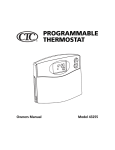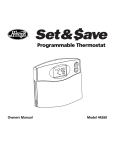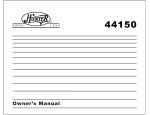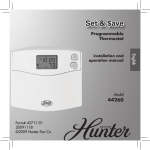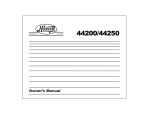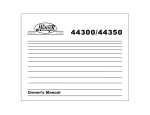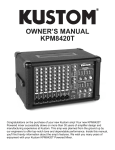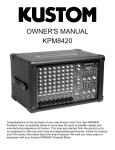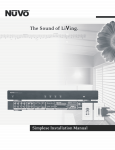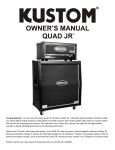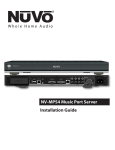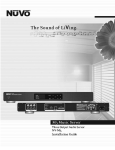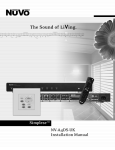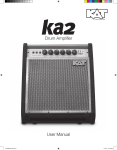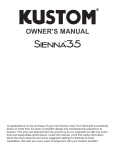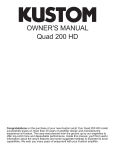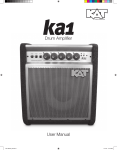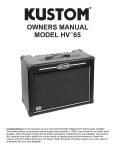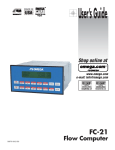Download Kustom Profile System Two User's Manual
Transcript
OWNER’S MANUAL Profile System Two TM Congratulations on the purchase of your new Kustom Profile System Two; a portable and powerful stereo P.A. System. Your new system offers unsurpassed sound quality as well as outstanding performance characteristics. Inside this manual you’ll find detailed information regarding the system’s many features. We wish you many years of enjoyment with your Kustom Profile System Two. ENGLISH IMPORTANT SAFETY INSTRUCTIONS 1. Danger Exposure to extremely high noise levels may cause a permanent hearing loss. Individuals vary considerably to noise induced hearing loss but nearly everyone will lose some hearing if exposed to sufficiently intense noise for a sufficient time. 2. 3. 4. 5. The U.S. Government's Occupational Safety and Health Administration (OSHA) has specified the following permissible noise level exposures: DURATION PER DAY (HOURS) 8 6 SOUND LEVEL (dB) 90 93 95 97 100 103 6. 7. 4 3 2 1 8. According to OSHA, any exposure in the above permissible limits could result in some hearing loss. Ear plugs or protectors in the ear canal or over the ears must be worn when operating this amplification system in order to prevent a permanent hearing loss. If exposure in excess of the limits as put forth above, to insure against potentially harmful exposure to high sound pressure levels, it is recommended that all persons exposed to equipment capable of inducing high sound pressure levels, such as this amplification system, be protected by hearing protectors while this unit is in operation. 9. 10. 11 . 12. CAUTION RISK OF ELECTRIC SHOCK DO NOT OPEN CAUTION: TO REDUCE THE RISK OF ELECTRIC SHOCK, DO NOT REMOVE CHASSIS. NO USER-SERVICEABLE PARTS INSIDE. REFER SERVICING TO QUALIFIED SERVICE PERSONNEL. Read all safety and operating instructions before using this product. All safety and operating instructions should be kept for future reference. Read and understand all warnings listed on the operating instructions. Follow all operating instructions to operate this product. This product should not be used near water, i.e. Bathtub, sink,swimming pool, wet basement, etc. Only use dry cloth to clean this product. Do not block any ventilation openings, It should not be placed flat against a wall or placed in a built-in enclosure that will impede the flow of cooling air. Do not install this product near any heat sources ;such as,radiators, heat registers, stove or other apparatus (including heat producing amplifiers) that produce heat. Do not defeat the safety purpose of the polarized or grounding-type plug. A polarized plug has two blades with one wider than the 0ther.A grounding-type plug has two blades and a third grounding prong. The wide blade or the third prong are provided for your safety If the provided plug does not fit into your outlet, consult an electrician for replacement of the obsolete outlet. Protect the power cord being walked on or pinched, particularly at Plugs, convenience receptacles and the point where they exit from the apparatus. Do not break the ground pin of the power supply cord. Only use attachments specified by the manufacturer. Use only with the cart, stand, tripod, bracket, or table specified by the manufacturer or sold with the apparatus. When a cart is used, use caution when moving cart/ apparatus combination to avoid injury from tip-over. Unplug this apparatus during lightning storms or when unused for long periods of time. Care should be taken so that objects do not fall and liquids are not spilled into the unit through the ventilation ports or any other openings. Refer all servicing to qualified service personnel. Servicing is required when the apparatus has been damaged in any way; such as, power-supply cord or plug is damaged, liquid has been spilled or objects have fallen into the apparatus, the apparatus has been exposed to rain or moisture, does not operate normally or has been dropped. WARNING: To reduce the risk of fire or electric shock, do not expose this apparatus to rain or moisture. S3125A AVIS: RISQUE DE CHOC ELECTRIQUE-NE PAS OUVRIR. 13. THIS SYMBOL IS INTENDED TO ALERT THE USER TO THE PRESENCE OF NON-INSULATED "DANGEROUS VOLTAGE" WITHIN THE PRODUCT'S ENCLOSURE THAT MAY BE OF SUFFICIENT MAGNITUDE TO CONSTITUTE A RISK OF ELECTRIC SHOCK TO PERSONS. 14. 15. THIS SYMBOL IS INTENDED TO ALERT THE USER TO THE PRESENCE OF IMPORTANT OPERATING AND MAINTENANCE (SERVICING) INSTRUCTIONS IN THE LITERATURE ACCOMPANYING THE UNIT. APPARATUS SHALL NOT BE EXPOSED TO DRIPPING OR SPLASHING AND THAT NO OBJECTS FILLED WITH LIQUIDS, SUCH AS VASES, SHALL BE PLACED ON THE APPARATUS. 16. 2 IMPORTANTES INSTRUCTIONS DE SECURITE FRENCH 1. Lire avec attention toutes les recommandations et précautions d'emploi avant d'utiliser ce produit. 2. Toutes les recommandations et précautions d'emploi doivent être conservées afin de pouvoir s'y reporter si nécessaire. 3. Lire et comprendre tous les avertissements énumérés dans les précautions d'emploi. 4. Suivre toutes les précautions d'emploi pour utiliser ce produit. 5. Ce produit ne doit pas être utilisé près d'eau, comme par exemple baignoires, éviers, piscine, sous-sol humides ... Etc. 6. Utiliser exclusivement un chiffon sec pour nettoyer ce produit. 7. Ne bloquér aucune ouverture de ventilation. Ne pas placer le produit tout contre un mur ou dans une enceinte fernée, cela gênerait le flux d'air nécessaire au refroidissement. 8. Ne pas placer le produit près de toute source de chaeur telle que radiateurs, arrivées d'air chaud, fourneaux ou autres appareils générant de la chaleur (incluant les amplificateurs producteurs de chaleur) . 9. Ne pas négliger la sécurité que procure un branchement polarisé ou avec raccordement à la terre, Un branchement polarisé comprend deux fiches dont l'une est plus large que l'autre. Un branchement à la terre comprend deux fiches plus une troisième reliée à la terre. Si la fiche secteur fournie ne s'insert pas dans votre prise de courant. consulter un 'électricien afin de remplacer votre prise obsolète. 10. Protéger le cordon d'alimentation de tout écrasement ou pincement, particulièrement au niveau des fiches, des réceptacles utilisés et à l'endroit de sortie de l'appareil. Ne pas casser la fiche de terre du cordon d'alimentation. 11. Utiliser uniquement les accessoires spécifiés par le constructeur. 12. Utiliser uniquement avec le chariot de transport, le support, le trépied, la console ou la table spécifiés par le constructeur ou vendus avec l'appareil. Lors de l'utilisation d'un chariot, bouger avec précaution l'ensemble chariotlappareil afin d'éviter les dommages d'un renversement. 13. Débrancher cet appareil lors d'orages ou s'il n'est pas utilisé pendant une longue période. 14. Des précautions doivent être prises afin qu'aucun objet ne tombe et qu'aucun liquide ne se répande à l'intérieur de l'appareil par les orifics de ventilation ou n'importe quelle autre ouverture. 15. Pour toutes interventions techniques s'adresser à un technicien qualifié.L'intervention technique est nécessaire lorsque l'appareil a été endommagé de n'importe quelle façon, comme par exemple si le cordon secteur ou sa fiche sont détériorés,si du liquide a coulé ou si des objets sont tombés à l'intérieur de l'apparei1,si l'appareil a été exposé à la pluie ou à l'humidité, s'il ne fonctionne pas normalement ou s'il est tombé. 16. ATTENTI0N:Pour réduire le risque d'incendie ou de choc electrique ne pas exposer l'appareil à la pluie ou à l'humidité. Danger L‘exposition a des niveaux eleves de bruit peut provoquer une perte permanente de l’audition, Chaque organisme humain reagit differemment quant a la perte de l’audition, mais quasiment tout le monde subit une diminution de I’acuite auditive lors d’une exposition suffisamment longue au bruit intense. Les autorites competentes en reglementation de bruit ont defini les expositions tolerees aux niveaux de bruits: DURE EN HEURES PAR JOUR 8 6 4 3 2 1 INIVEAU SONORE CONTINU EN dB 90 93 95 97 100 103 Selon les autorites, toute exposition dans les limites citees ci-dessus,peuvent provoquer certaines pertes d’audition. Des bouchons ou protections dans l’appareil auditif ou sur l’oreille doivent etre portes lors de l’utilisation de ce systeme d’amplification afin de prevenir le risque de perte permanente de l’audition, Dans le cas d’expositions superieures aux limites precitees il est recommande, afin de se premunir contre les expositions aux pressions acoustiques eIevees potentielIement dangeureuses, aux personnes exposees aux equipements capables de delivrer de telles puissances, tels ce systeme d’amplification en fonctionnement, de proteger l’appareil auditif. ATTENTION RISQUE DE CHOC ELECTRIQUE NE PAS OUVRIR. S3125A ATTENTION: AFIN DE LlMlTER LE RISQUE DE CHOC ELECTRIQUE, NE PAS ENLEVER LE CHASSIS. NE CONTIENT PAS DE PIECES POUVANT ETRE REPAREE PAR L’UTILISATEUR. CONFIER LE SERVICE APRES-VENTE AUX REPARATEURS AGREES. CE SYMBOLE A POUR BUT D'AVERTIR L'UTILISATEUR DE LA PRESENCE DE VOLTAGE DANGEREUX NON-ISOLE A L'INTERIEUR DE CE PRODUIT QUI PEUT ETRE DE PUISSANCE SUFFISAMMENT IMPORTANTE POUR PROVOQUER UN CHOC ELECTRIQUE AUX PERSONNES. CE SYMBOLE A POUR BUT D'AVERTIR L'UTILISATEUR DE LA PRESENCE D'INSTRUCTIONS D'UTILISATION ET DE MAINTENANCE DANS LES DOCUMENTS FOURNIS AVEC CE PRODUIT. AFIN DE REDUIRE LES RISQUÉ D'INCENDIE ET DE DECHARGE ELECTRIQUE, NE PAS EXPOSER CET APPAREIL A LA PLUIE OU A L'HUMIDITE. 3 Table of Contents Profile System Two Contents Optional Accessories Profile System Two Features Setup Diagram A - Mixer Front Setup Diagram B - Mixer Back Setup Diagram C - Speaker Cabinet Back Setup Instructions About the Master Section About the Input Section About the Output Section FAQ Frequently Asked Questions Amplifier Loading Chart Block Diagram Specifications EC Declaration of Conformity Kustom Contact Information 4 5 5 5 6 7 8 9 10 11 14 15 16 17 18 19 20 Profile System Two Contents These items are included with your Profile System Two: • (1) 300-Watt Stereo Powered Mixer • (2) Line Array Speaker Cabinets • (2) 25-Foot Speaker Cables • Owner’s Manual • Warranty Card Optional Accessories: • Convenient Roller Bag for Easy Transport (KPSRB220) • Kustom Profile Stands for Speakers & Mixer (KPSSS200) • Kustom Profile Microphone with accessories (KPS-DM120) Profile System Two Features Profile Two Powered Mixer • Power: 300 Watts RMS Total - 150 Watts Per Channel (Stereo) • 8-Band Master EQ With Sub-Frequency/Subwoofer Control • 6 Channels (5 Balanced XLR & 1/4” Combo Inputs, 1 Auxiliary Channel) • Stereo Input on 5th Channel • Instrument-Ready Preamp on 5th Channel • 2-Band EQ (Bass & Treble) controls per channel • Monitor Volume Control Per Channel • Stereo Panning Control Per Channel • Discrete Stereo AUX Channel with 2-Band EQ • Stereo Mic-In and Line-In Inputs (1/8”) on AUX Channel • 24-Bit Digital Effects Processor with 16 Effects • Exclusive Double Take Vocal Double Track Simulator • Phantom Power • Effects Loop • Mounts on optional Kustom Profile Stand (KPSSS200) TM Profile Two Speakers • Two Heavy-Duty 8” Speakers per Enclosure • One Neodymium Compression Driver with 1” Exit per Enclosure • Line Array Technology for Focused Dispersion • Mounts on optional Kustom Profile Stand (KPSSS200) 5 SETUP DIAGRAM A MIXER FRONT 6 SETUP DIAGRAM B MIXER BACK 7 SETUP DIAGRAM C SPEAKER CABINET BACK Speaker Input Jack (Y) This jack is used to connect the Speaker Output Jack (R or W) to the speaker. This should be connected with a good quality speaker cable. 8 Setup Instructions: Making Connections: • Using the Profile speaker cables, or a set of your own, connect an end of each cable into the speaker outputs of the mixer (R & W). Then connect the opposite end of each cable to the appropriate speaker cabinet input (Y). Hint: For ease of use, connect the right output jack (R) to the speaker cabinet on the right side of the mixer front and connect the left output jack (W) to the speaker cabinet on the left side of the mixer front. Doing this will ensure that the pan control (E) will be in sync with the appropriate speaker. • If you are using a powered monitor, connect the input of the powered monitor to the monitor output jack (T) on the back of the mixer. • If you are using a powered subwoofer, connect the input of the powered subwoofer to the sub output jack (U) on the back of the mixer. • Be sure that the power switch (S) is set to the “off” position and then attach the AC cable to the AC input jack (X). • Plug in the microphones and instruments you plan to use into the mic/line combination jacks (L & M). Note: If you are using an instrument that has a stereo output connect that one to the mic/line combination jack on channel 5 (M) using a stereo (tip/ring/sleeve) cable. If you are using a passive acoustic instrument, you should use the mic/line combination jack on channel 5 (M) and set the inst/line switch (H) to the inst position. • If you are using an audio source, such as a CD player or computer, connect the output of the source to the RCA input jacks (I) or the line input jack (J). • If you are using a microphone with a mini (1/8”) plug, you can use the mic in jack (K) to connect to the mixer. Master Section: • Turn the master volume control (3) and the monitor volume control (5) counter-clockwise to the lowest setting. • Set the master equalizer controls (2) to their center positions (0dB). • If you are not using a subwoofer, set the sub volume to the center position. If you are using a subwoofer, set the sub volume to its lowest position. • Turn the effects volume control (6) counter-clockwise to the lowest setting. Input Section: • • • • • Turn all volume controls (G) counter-clockwise to their lowest positions. Set the pan controls (E) to their 12 o’clock positions. Set the treble and bass controls (C & D) to their 12 o’clock positions. Turn the monitor controls (B & F) counter-clockwise to their lowest positions. Turn the effects controls (A) counter-clockwise to their lowest positions. Playing: • Turn the power switch (S) to the “on” position. Note: The power indicator (4) on the front of the mixer should now be lit. • Turn the master volume control (3) clockwise to the 9 o’clock position and begin adjusting the volume controls (G) of the individual channels (that you are using) clockwise to reach desired level. After you are happy with the basic level, you then use the master volume control (3) to increase or decrease the overall amount of volume. Note: If you are using a powered subwoofer, adjust the sub volume slider (1) to the center position. After setting the basic level, you can then adjust this control to increase or decrease the output of the powered subwoofer. • Adjust the treble and bass controls (C & D) on the individual channels and the master equalizer controls (2) to achieve the desired sound. • Turn the master effects volume control (6) clockwise to the 9 o’clock position and begin adjusting the effects controls (A) on the individual channel to achieve the desired amount of digital effects for each channel. Note: You should also turn the effects selector control (7) to the desired effect selection and press the effects active switch (0) to the “on” position. 9 About the Master Section The master section gives you final control over the sum of what is happening in the input section. In other words, the adjustments you make in this section will affect all channels evenly. Sub Volume Control (1) When using a powered subwoofer that is connected into the sub output jack (U), this control becomes a volume control for the subwoofer. The output signal level can be adjusted by + or 12dB. When not using a powered subwoofer, this control becomes part of the equalizer section. This control will adjust the sub frequencies by + or - 12dB. Equalizer Controls (2) These controls are used to adjust the sound to your taste. The individual frequencies (100Hz, 250Hz, 500Hz, 1KHz, 2KHz, 4KHz, 10KHz) can be adjusted by + or - 12dB. Master Volume (3) This control is used to adjust the overall output volume of the mixer. Adjusting this control will also adjust the output of the sub output jack (U) when a powered subwoofer is used. Although the sub volume control (1) will still adjust the output level up or down. Power Indicator (4) This indicator will light when power is applied to the amplifier. Monitor Volume (5) This control will adjust the overall output volume going to the monitor output jack (T). Effects Volume (6) This control will adjust the overall amount of effects that will be mixed into the outputs. Effects Selector Switch (7) This switch is used to select the type of digital effect you want to use. There are 16 different digital effects to choose from. These are the available effects: Reverb: Small Room Medium Room with Pre Delay Large Room Large Hall Plate Reverb Chorus: Chorus Slow Chorus Fast Double Take/Chorus Delay: Doubler Slapback Echo Delay 400ms Double Take Combos: Double Take/Reverb Chorus/Reverb Chorus/Delay/Reverb TM Effects To Record Out Switch (8) This push button switch is used to send effects to the record out jacks (V) on the back of the mixer. Effects To Monitor Switch (9) This push button switch is used to send effects to the monitor out jack (T) on the back of the mixer. Effects Active (0) This push button switch is used to activate the digital effects. When this switch is set to the “off” position the effects will be bypassed. 10 About the Input Section The input section is where you connect microphones, guitars, drum machines, keyboards, and other audio sources. Effects Control (A) This control is used to send the signal from the individual channel to the digital effects. The effects volume control (6) adjusts the overall volume for this control. Monitor Control (B) This control is used to send the signal from the individual channel to the monitor output jack (T). The monitor volume control (5) adjusts the overall volume for this control. Treble Control (C) This control is used to adjust the amount of “high” frequency applied to the individual channel. Bass Control (D) This control is used to adjust the amount of “low” frequency applied to the individual channel. Pan Control (E) This control is used to send the signal from the individual channel to the left and/or right outputs of the mixer. Setting this control to the 12 o’clock position will send signal equally to both left and right outputs. Aux Monitor Control (F) This control will adjust the overall amount of input signal from the Aux channel that is sent to the monitor output jack (T). Volume Control (G) This control will adjust the overall amount of input signal of the individual channel that is sent to the Master Volume Control (3). Instrument/Line Switch (H) If you are using a string instrument, such as an acoustic guitar that has a passive pickup (nonbattery powered) or an electric guitar without an amp, then you should connect it to channel five and set this switch to instrument (“inst”). Setting the switch to instrument alters the equalization of the channel to bring out the sweet frequencies of any string instrument, such as acoustic and electric guitar, mandolin, cello, violin, or other stringed instruments. RCA Input Jacks (I) These jacks are used to connect any audio device that uses the RCA type plugs. Note: There are left and right inputs which are automatically kept stereo through the entire system. Basically, what is connected to the left input will come out of the left speaker. The same is true for the right. Aux Line In Jack (J) This jack accepts a stereo (tip/ring/sleve) 1/8” plug. This should be used to connect a device with a line level output such as a CD player or computer. Mic In Jack (K) This jack can be used to connect a microphone that has a 1/8” plug such as a computer microphone. This jack has phantom power for microphones that require it. Combination Input Jacks (L) These jacks are used to connect any audio source to the mixer, such as microphones, guitars, keyboards, drum machines, CD players, etc. These mono jacks will accept either 1/4” plugs or XLR type plugs. 11 Methods for connecting inputs to channels Method 1: Microphone using XLR balanced inputs This is the most popular method for connecting microphones. It works with both dynamic and condenser low impedance microphones. Acoustic guitars that have XLR balanced outputs can also use this input. Because of the phantom power on these inputs, a battery may not be needed. Check the 2 1 3 manufacturer of your instrument for use without a battery. MICROPHONE BALANCED MIC CABLE CH 1~5 INPUT Method 2: Line level instrument using line input and a hi-z instrument cableThis method uses the mono line output through a hi-z instrument cable. Pros: A quick simple way to get an instrument into the PA without special cables or adapters. This method gives good results in most situations for short distances. Cons: Using an un-balanced cable longer than 25 feet runs the risk of hum and noise. Using this method in CH5 does not take Line Out advantage of its full stereo input feature. Right Left (mono) 1/4” MONO INSTRUMENT CABLE LINE LEVEL INSTRUMENT CH1~5 INPUT Method 3: instrument with passive pickup using hi-z input and cable (CH 5 only)This method uses the hi-z (hi impedance) feature of channel 5. For best results, have the inst/line switch in the instrument (pressed in) position. This channel will automatically switch to mono mode using this method. Pros: A quick simple way to get a low output passive pickup instrument into the PA without special battery powered adapters. Cons: You run the risk of hum, noise and de-graded signal if cables longer than 15 feet are used. CH 5 INPUT 1/4” MONO INSTRUMENT CABLE Method 4: CD/MP3, computer etc. using aux line in- INSTRUMENT WITH PASSIVE PICKUP AUX DEVICE’S This method is for connecting devices that have 1/8” stereo or RCA line level outputs. The stereo separation of the device is maintained throughout the system. Headphone outputs can also be used as long as the level is kept low enough to prevent overloading the input. It is OK to use all three aux inputs at once. Pros: Provides a quick simple way to get pre-recorded music 1/8” STEREO CABLE into the PA. All three of the aux inputs can be used together. Cons: Right/left panning (balance) must be done with the input LINE INPUTS device. RCA STEREO CABLE Method 5: Unbalanced condenser mic with 1/8” plug This method is for connecting 1/8” mono or stereo condenser microphones typically used with computers. The ring and tip are typically tied together on mono microphones. The phantom supply is less voltage than the other Mic inputs. Pros: Provides a quick simple way to connect small Mics. The other two aux inputs can be used together with this mic input so in a way, it’s like getting an extra Mic channel. MICROPHONE Cons: Caution must be taken to not create feedback in the system 1/8” STEREO CABLE with this type of Mic. There are many low quality microphones of this type that offer little or no feedback rejection. MIC IN 12 About the Input Section (Cont.) Combination Input Jack (M) This jack functions the same as the other combination jacks (L) except the 1/4” input can be stereo, mono, or hi-Z mono. String instruments, such as acoustic guitar that have a passive pickup (nonbattery powered) are typically hi-z mono and will work best in this channel. Line level stereo instruments such as electronic keyboards and drum machines are excellent choices for this channel, because it maintains the instrument’s stereo signal through the two separate preamps of channel 5. There is no need to be concerned if the instrument is stereo or mono because the channel automatically switches to mono if no signal is present on the ring of the 1/4” input, or if a standard mono guitar cord is used. In the stereo mode, the tip is assigned to the left preamp and the ring to the right preamp of channel 5. When no signal is present on the ring, or if a mono 1/4" plug is used, the signal present on the tip will be assigned to both left and right preamps of channel 5. Methods for connecting instruments to channel 5 Method 1: Stereo using individual left and right line outputs of an electronic instrument - Tip Rin (left) g( Sle Righ t) ev e( Sh iel d ) This method maintains stereo integrity from the instrument to speakers taking full advantage of the stereo feature channel 5 offers. Pros: Delivers a full rich sound on instruments with stereo effects. Cons: May require a 1/4” Stereo Adapter wire if your instrument does not have a single stereo Line Out jack. KEYBOARD Headphone Right Left (mono) (or similar electronic instrument) Right RING TIP Left CH 5 INPUT 1/4” STEREO ADAPTER 1/4” INSTRUMENT CABLES Method 2: Stereo using Headphone outputThis method gives the same result as the first method with a single cable. The headphone volume on the instrument should set for a good mix in the PA when channel 5 volume is half way up. If the headphone volume is too high, it can overload channel 5 and sound distorted. Pros: Same as method 1 but with less clutter. Cons: The musician playing the instrument Line Out must remember that too much headphone level Headphone Right Left (mono) can distort the channel. Tip Rin (le)ft g( Sle Righ t) ev e( Sh iel d ) KEYBOARD CH 5 INPUT (or similar electronic instrument) 1/4” STEREO INSTRUMENT CABLE CH 5 INPUT (Sh ie ve Sle e Tip (le ft) ld ) Method 3: Mono using mono Line out This method uses the mixed stereo signal of the instrument. This method can also be used on channels 1~4. Pros: If this is a multi-instrument keyboard, there will be a balanced mix of the instruments in both speakers. Cons: This method does not take advantage of the stereo feature unique to channel 5. Line Out KEYBOARD Headphone (or similar electronic instrument) 1/4” STEREO INSTRUMENT CABLE 13 Right Left (mono) About the Output Section The output section (mixer back) is where you connect your speakers, recording equipment, and any other external sound conditioning device. Left Preamp Output (N) This jack can be used to connect the left output to an external audio device such as a power amp. This output is line level. Right Preamp Output (O) This jack can be used to connect the right output to an external audio device such as a power amp. This output is line level. Left Power Amp Input (P) This jack can be used to connect an external line level audio device directly to the left power amp. Note: When this jack is used, the signal from the mixer will no longer be going to the left power amp. The Left Preamp Output (N) and this jack can be used together to place a sound conditioning device, such as an equalizer, directly in line with the left channel of the mixer. The preamp out should be connected to the input of the device and the output of the device should be connected to this jack. Right Power Amp Input (Q) This jack can be used to connect an external line level audio device directly to the right power amp. Note: When this jack is used, the signal from the mixer will no longer be going to the right power amp. The Right Preamp Output (O) and this jack can be used together to place a sound conditioning device, such as an equalizer, directly in line with the right channel of the mixer. The preamp out should be connected to the input of the device and the output of the device should be connected to this jack. Right Speaker Output (R) This jack is used to connect the right speaker to the mixer. Note: This should be the speaker that is on the right side of the mixer front. The right on the Pan Control (E) will then correspond to the right speaker. Power Switch (S) This switch is used to apply AC power to the mixer. Monitor Output (T) This jack is used to connect an external power amp or powered monitor to the mixer. The overall output of this jack is controlled by the Monitor Volume Control (5). Sub Output (U) This jack is used to connect a powered sub woofer to the mixer. When using this jack the Sub Volume Control (1) will adjust the level of output to the sub woofer. RCA Record Out Jacks (V) These output jacks are used to send a line level signal to any audio device that uses the RCA type plugs for an input. These can be used to record directly from the mixer. Left Speaker Output (W) This jack is used to connect the left speaker to the mixer. Note: This should be the speaker that is on the left side of the mixer front. The left on the Pan Control (E) will then correspond to the left speaker. AC Input Jack (X) This jack is used to connect AC power to the Profile System Two. 14 FAQ Frequently Asked Questions: 1. How many speakers can I use with the Profile Two? ANSWER: Most speaker cabinets today are 8-ohms. For the sake of this question we will assume this is the case. You can use a total of four 8-ohm speakers with the Profile Two: Two for the Left power-amp and two for the Right power-amp. The Profile Two cabinets are 4-ohms each. DO NOT connect more than one of these cabinets per power-amp. DO NOT plug more than two 8-ohm speakers or one 4-ohm speaker into each poweramp. 7. I get this nasty pop when turning the microphone switch on or off. What’s wrong? ANSWER: The microphone or cord is probably wired incorrectly or uses the wrong type of cable. The pop occurs when the phantom supply on a channel is shorted to shield ground. A properly wired XLR cord uses 2 conductor shielded cable. The shield connects to pin 1 and the center conductors go to pins 2 and 3. There cannot be a jumper or short between pins 2, 3, and the shield. The microphone is wired correctly when the signal on pin 2 and 3 short to each other when switched off. 2. The speaker has no sound when plugged into the monitor or sub-woofer output jacks on the rear panel. What’s wrong? ANSWER: These are line level output jacks not capable of driving a speaker directly. Use only powered monitors, sub-woofers,or an external power amp with these jacks. 8. Can I use an external Power-amp with my Profile Two? ANSWER: Yes! An external power amp can be connected to the left or right preamp out, Monitor , or Sub-woofer jacks on the rear. 3. I only have a non-powered monitor. Is there any way to use it? ANSWER: Yes, run a patch cord between the monitor out and the left or right power amp in. Doing this will disable the left or right mains preamp out from that power amp. The speaker connected to that power amp will be controlled by the master monitor volume. 9. Not all of my microphones are condenser type. Will the Phantom Power in the Profile Two damage my non-condenser mics? ANSWER: No. You can safely use a combination of condenser and dynamic microphones at the same time. 10.I have the effects volume turned up, effects active and effects to monitor buttons pushed in, but still do not hear any effects through the monitors. Why? ANSWER: The Main volume and/or the effects send on the channel is not turned up . 4. What can I do to reduce microphone feedback? ANSWER: Keep the microphones away from and behind the speakers. If this is not possible, try panning the channel to the opposite speaker of the offending microphone. The goal is to prevent sound produced by the speaker from entering the front of the microphone. The master graphic EQ also works well for controlling feedback when one or two frequencies are a nuisance. Be careful not to cut too many of the frequencies on the graphic EQ. This will cause the sound to lose clarity and become thin. If you notice this happening, lower the master volume and raise some of the EQ sliders. 11. I have a channel that I want in the Mains but not in the monitors. The Monitor Volume on the channel is all the way down but it still comes through the monitors. Where is this coming from? ANSWER: It is coming from the digital effect. To correct this, do not assign effects to the monitor or keep the effects level down for that channel. 5. My digital Keyboard is distorting, especially on the piano sounds. ANSWER: Adjust the output level of the keyboard so that the Profile Two channel volume is halfway or more. Be especially careful with piano and percussive sounds. They can be very dynamic and overload the channel on attacks when the channel has high output with the volume set low. 12.The master volume is all the way down but the record output on the rear panel still has signal. Is this normal? ANSWER: Yes, the record output is pre-master volume. This allows you to set the record level independently from the master output. You can use the preamp outputs if you wish the master volume to control the record level. 6. My acoustic guitar has a pick up that is plugged into channel one. It is not loud enough even with the channel volume all the way up. Do you think I have a bad cord? ANSWER: No. This guitar has a Hi-Z passive pickup. Use channel 5 in the instrument mode for this type of input. You can also purchase a battery powered preamp for the guitar pickup to use channels 1 thru 4. 15 The Profile System Two mixer and speakers have been specifically designed and optimized for use together as a package. The mixer has been designed to deliver maximum power with a 4-ohm load on each channel. If you choose to use different speakers with the mixer, refer to the chart below for loading information. Amplifier Loading Chart (each channel) Speaker cabinet loads (ohms) applied to the amplifier Cabinet B’s Impedance open 16 8 5.33 4 3.20 2.67 2 Cabinet A’s Impedance (ohms) open 16 8 5.33 4 3.20 2.67 2 open 16 8 5.33 4 3.2 2.67 2 16 8.00 5.33 4.00 3.20 2.67 2.29 1.78 8 5.33 4.00 3.20 2.67 2.29 2.00 1.60 5.33 4.00 3.20 2.67 2.29 2.00 1.78 1.45 4 3.20 2.67 2.29 2.00 1.78 1.60 1.33 3.2 2.67 2.29 2.00 1.78 1.60 1.46 1.23 2.67 2.29 2.00 1.78 1.60 1.46 1.34 1.14 2 1.78 1.60 1.45 1.33 1.23 1.14 1.00 Total load on amplifier Note: To prevent overheating and possible loss of signal, do not use any combination of cabinets that results in a box that is shaded. This chart can help you determine what load (ohms) is present on the amplifier when using multiple cabinets. - To use this chart with two cabinets (A and B), find cabinet A’s impedance (ohms) column and cabinet B’s impedance row on the chart. The total load on the amplifier is shown in the box where they meet. For example: If cabinet A’s impedance is 8 ohms and cabinet B’s impedance is 4 ohms, the total load on the amplifier would be 2.67 ohms. - To use this chart with three or more cabinets, find the total load for two cabinets and then use the result for cabinet A’s impedance column. The third cabinet will then be used for cabinet B’s impedance row on the chart. Find the total load on the amplifier and repeat if more cabinets are used. For example (using 3 cabinets): If the first cabinet (cabinet A) has an impedance of 16 ohms and the second (cabinet B) has an impedance of 8 ohms, the total load would be 5.33 ohms. Using this load (5.33) as cabinet A’s impedance and a third cabinet’s (new cabinet B) impedance of 4 ohms, you would find that the total load on the amplifier is 2.29 ohms. Note: It is not recommended to use any combination of cabinets that has a resulting load in a shaded area of the chart. 16 17 RCA RING (R) SLEEVE RING (R) TIP (L) SLEEVE RIGHT LEFT Line MIC TIP (L) AUX IN SLEEVE Line/Inst TIP (L/mono) RING (Right) Microphone Hi-Z Amp + - Preamp Preamp Right Sum-amp Left Sum-amp LINE/INST + - Phantom Power Right Sum-amp Left Sum-amp Phantom Power Mic/Line(mono/stereo)-Inst. Phantom Power Input Jack CHANNEL 5 TIP (+) RING (-) SLEEVE Line Microphone Mic/Line Input Jack Vol. Tone R L Tone LE SS REB BA T Vol./ Sum MONITOR R L Vol. Vol. Vol. Vol. MAIN LE SS REB MAIN A B T Vol. MONITOR Tone LE SS REB A B T MAIN R L Vol./ Sum R L Vol. R L EFFECTS Vol. EFFECTS MONITOR PAN PAN MONITOR MONITOR INPUT CHANNEL BUSS MAIN RIGHT MAIN LEFT MAIN RIGHT MAIN LEFT CHANNEL 1 - 4 EFFECTS RIGHT EFFECTS LEFT EFFECTS RIGHT EFFECTS LEFT Profile Two Block Diagram signal sensor R L Vol. HP Filter LP Filter Vol./ Sum R L Vol. Vol. Sum TO MONITOR EFFECTS ACTIVE R L K 10 Sum 7 Band EQ EFFECTS VOLUME MONITOR R L R L 0 10 L R Sub Sum MASTER Sub Sensor Digital Effects Sum. Sum. Vol. MASTER VOLUME R L Vol. SUB VOLUME Sum TO RECORD OUT R L Power Module Right Limiter Left Limiter Right Amp 150W/4 ohm Left Amp 150W/4 ohm Ring TIP R Speaker Out Jack TIP L Speaker Out Jack TIP R Power Amp In Jack Switch L Power Amp In Jack Switch TIP Monitor Out Jack TIP Record Output Jack R L R Preamp Out Jack TIP L Preamp Out Jack TIP SUB Out Jack Switch TIP REAR JACKS Profile System Two Specifications Model Output Power, Both Channels Driven Accepted Inputs Frequency Response Total Harmonic Distortion Hum & Noise System Gain per Channel Input Channel Equalization Master Equalization Sub Woofer Digital Effects Phantom Power Power Requirements Dimensions & W eight Model Power Capacity Frequency Response Nominal Impedance Dimensions & W eight Per Cabinet KPS-PM300 145W per channel 150W per channel 170W per channel CH 1 - 4 6 Channel Dual Powered Mixer 4 Ohms @ 0.1% THD 4 Ohms @ 1% THD 4 Ohms @ 5% THD Mic XLR Balanced, Line 1/4" Balanced/Un-balanced Mic XLR Balanced, Line 1/4" Un-Balanced Mono or CH 5 Stereo, Hi-Z instrument Un-Balanced Mono Mic & line 1/8" stereo, RCA Stereo. Any combination Aux of these inputs can be used at once. Actual response is tailored to speaker cabinet for 20HZ-20kHz accurate acoustical response. Measured at 1VRMS (0dBv) at record output, preamp Less than 0.4% output, or monitor output. -110 dB Mic Input, Rs=150 ohm, 20-20kHz -60dB Residual Noise, all level controls 0% (minimum) -55dB Nominal System Noise, all level controls at 50% All Measurements made at 1kHz unless noted +70dB Mic to Speaker Output (Ch 1 - 5) +70dB Mic to Speaker Output (Aux) +50dB Line to Speaker Output (CH 1 - 5) +50dB Stereo Line to Speaker Output (CH 5) +45dB Line to Speaker Output (Aux) +40dB Mic to Sub Output ( measured using 80Hz) +40dB Mic to Preamp Output +40dB Mic to Monitor out +40dB Mic to Record out +30dB Power amp in to Speaker Output Special curve that adjusts Bass and Treble frequencies 100 to 10kHz, 7 Band, 1 Octave Graphic, all ±12dB 120Hz fixed, Low Pass 24 bit DSP 16 preset stereo digital effects taylored for PA applications. +40V +5V USA/Canada Europe UK Australia Japan mm/kg Inches/Pounds Mic inputs (Ch 1 - 5) Mic input (Aux) 120VAC/60Hz, 200W nominal 230VAC/50Hz, 200W nominal 230VAC/50Hz, 200W nominal 240VAC/50Hz, 200W nominal 100VAC/50-60Hz, 200W nominal 345 (Height) x 252 (Width) x 290 (Depth), 11 kg 13.6 (Height) x 10 (Width) x 11.5 (Depth), 24.2 lbs KPS-LS300 150W each 300W each 60HZ-20kHz 4 Ohms mm/kg Inches/Pounds Profile System Two Loudspeaker System EIA RS-426 Program Power (music power) +/- 3dB Per Cabinet, Accurate acoustical response 542 (Height) x 272.2 (Width) x 290 (Depth), 11.6 kg 21.4 (Height) x 10.75 (Width) x 11.5 (Depth), 25.5 lbs 18 EC Declaration of Conformity We: Kustom Musical Amplification Inc. 4940 Delhi Pike Cincinnati, OH 45238 Tel: 1-513-451-5000 Fax: 1-513-347-2192 Declare that the product Product name: Kustom Product model number: Profile System Two to which this declaration relates is in conformity with the following standards; EN55013 (A12) : 1995 Limits and methods of measurement of radio disturbance characteristics of broadcast receivers and associated equipment. EN55020: 1995 Electromagnetic immunity of broadcast receivers and associated equipment. EN61000-3-2: 1995 Limits for harmonic current emissions (equipment input current < 16A per phase). EN61000-3-3: 1995 Limitation of voltage fluctuations and flicker in low voltage supply systems for equipment with rated currents < 16A. EN55103-1: 1995 Electromagnetic Compatibility - Product family standard for Audio, Video Audio-visual and entertainment Lighting Control Apparatus. EN60065: 1994 Safety requirements for main operated electronic and related apparatus for household and similar general use. Following the provisions of EU Council Directive(s): 72/73 EEC and 89/336/EEC. We the undersigned, hereby declare that the equipment specified above conforms to the aforementioned directive(s). Name of authorized person: James Brown, Chief Engineer Signature:______________________ Date: 17 November 2004 Kustom Amplification Inc. 4940 Delhi Pike Cincinnati, OH 45238 Tel: 1-513-451-5000 Fax: 1-513-347-2192 19 ® Kustom Amplification Inc., 4940 Delhi Pike, Cincinnati, OH • USA (800) 999-5558 Web: www.kustom.com




















